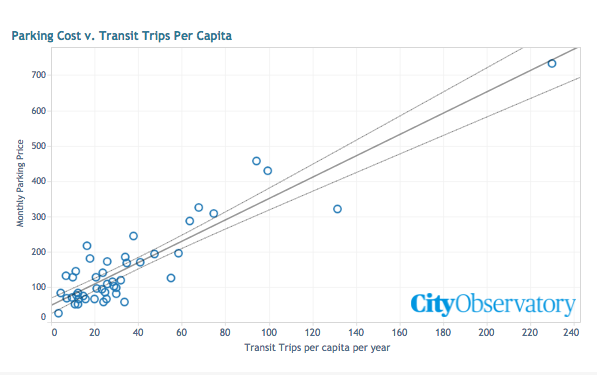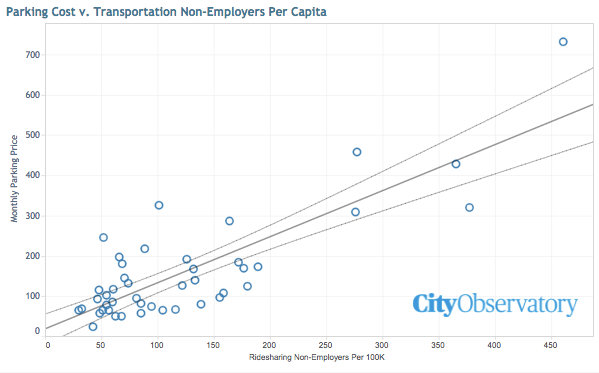What the Price of Parking Shows Us About Cities
2:27 PM EDT on October 24, 2016

Cross-posted from City Observatory.
Earlier, we rolled out our parking price index, showing the variation in parking prices among large US cities. Gleaning data from ParkMe, a web-based directory of parking lots and rates, we showed how much it cost to park on a monthly basis in different cities. There’s a surprising degree of variation: While the typical rate is somewhere in the range of $200 a month, in some cities (New York) parking costs more than $700 a month, while in others (Oklahoma City) it's less than $30 a month.
As Donald Shoup has exhaustively explained in its tome, The High Cost of Free Parking, parking has a tremendous impact on urban form. And while Shoup’s work focuses chiefly on the side effects of parking requirements and under-priced street parking, we’re going to use our index of parking prices to explore how market-provided parking relates to the urban transportation system.
In the United States, the majority of commuters travel alone by private automobile to their place of work. But in some places -- in large cities and in dense downtowns -- more people travel by transit, bicycle or walk to work. It’s worth asking why more people don’t drive. After all, the cost of car ownership is essentially the same everywhere in the U.S. The short answer is that in cities, parking isn’t free. And when parking isn’t free, more people take transit or other modes of transportation.
To see just how strong an explanation that parking prices provide for transit use, we’ve plotted the number of transit trips per capita in each of the largest metropolitan areas against the typical price of a month of parking in the city center. Each data point represents a single metropolitan area. There’s a very strong positive correlation between transit rides per capita and parking rates. Cities with higher parking rates have more transit rides per capita than cities with lower parking rates. The statistical correlation between the two measures is extremely strong: The coefficient of determination (R2) is .83, suggesting that parking rates statistically explain 83 percent of the variation in transit use among cities.
It's worth noting that this relationship is based on extremely coarse data about both parking prices and transit use. We’ve measured transit use for entire metropolitan areas (including dense centers and distant suburbs) and looked only at parking rates in and around the city hall of the largest city in each metropolitan area. A more nuanced examination of parking rates and transit ridership (one, for example, that looked at parking rates and transit use in particular neighborhoods), might show an even stronger relationship.
What this points out is that private car commuting is extremely sensitive to the price commuters must pay. For most commutes, commuters don’t have to pay for parking -- their employers provide (often by regulatory fiat) “free” parking. When confronted with paying the cost of parking (and the average is about $6 per day at a monthly rate), many more people choose to travel by other modes of transportation.
This suggests that there is much more opportunity to influence travel behavior by pricing than we commonly appreciate. In effect, what pricing of parking in some metropolitan areas is doing is correcting for the market failure of not pricing roads.
As we’ve frequently noted at City Observatory, we don’t directly charge for road use in the United States. Motorists pay some road use fees, based almost entirely on fuel consumption (which, incidentally, don’t come close to covering the cost of the roads system). Importantly, the way we charge for roads through fuel taxes bears no relationship to the roads motorists actually use, or the time that they use them. And, as a practical matter, the cost and capacity of the road system are largely shaped by peak hour travel in urban places.
It's worth asking why private sector firms build and operate parking lots in some locations (and not others) and why car owners pay much higher rates to park in some cities than others. An essential fact of private car travel is that it requires that owners have a place to store their vehicle at their origin and at their destination. In urban centers, there’s more demand for travel -- and parking spaces -- than can be met, with the effect that the price of parking is higher than elsewhere. In effect, private parking lots capture the the value associated with peak period car travel to dense urban destinations. Because we don’t charge for the use of the roads during the peak hour, private lots are able to capture some of the economic rents associated with access to the urban center at the peak hour.
The high value that people attach to access to urban centers is attracting a disruptive new entrant to the urban transportation market: ride-hailing services like Uber and Lyft. Our data show that the growth of these services -- as proxied by the Brookings Institution’s recent estimates of the growth of non-employer transportation service providers -- is also closely correlated with high parking rates. In the following chart, we show the correlation between city parking rates (on the vertical axis) and the number of transportation service non-employers per 100,000 metropolitan population. As with transit trips, there’s a strong, positive correlation. The coefficient of determination is .68, implying that parking prices statistically explain about 68 percent of the variation in the penetration of ride hailing services among metropolitan areas.

This makes perfect sense: The richest market for ride-hailing is going to be in those places where it is most inconvenient and expensive to park a car. Ride-hailing is highly attractive if one’s alternative is to drive your own car, and have to hunt for, drive to, and then pay for parking. Conversely, if parking is free and abundant at your destination, there’s much less incentive to use Uber or Lyft, particularly if one already owns a private vehicle.
The strong relationship between parking prices and transit use, and between parking prices and the uptake of ridesharing has important implications for the future of urban transportation.
First and foremost, it serves as reminder that prices offer powerful incentives that shape travel behavior. Transit is most heavily patronized in those cities where motorists have to pay relatively high prices for parking, and least used where parking is free.
Second, it suggests that the most lucrative markets for ride-hailing services will be in relatively dense places (with lots of potential customers) and where parking is more expensive or scarce (making ride-hailing more attractive). We would expect low density suburbs and rural areas to be the least attractive markets ride-hailing services.
Third, the price of parking currently operates as a kind of surrogate or shadow-price for roads in dense central cities. Fewer people drive, and more people take transit another modes, because of the high cost of parking. But as ride-sharing services expand, the constraint on demand for car travel in central cities imposed by high parking prices will disappear, with the effect that there will likely be much more demand for on-street travel. While city streets are un-priced, peak hour travel by Uber and Lyft is not. In fact, these operators both utilize surge pricing. As a result, it seems likely that the growth of ride-hailing, particularly with services that use surge pricing, transportation providers will capture some of the economic rents associated with peak period congestion. Profits for this sector are built in part on capturing the scarcity value of urban streets, which are un-priced or under-priced for both vehicle movement and storage.
The price of parking is an under-appreciated aspect of the urban transportation system. As we wrestle with the disruptions from ride-hailing services, and perhaps soon, autonomous vehicles, what happens to parking prices could have major impacts on our cities.
Stay in touch
Sign up for our free newsletter
More from Streetsblog USA
Friday’s Headlines Got Served
Another day, another GOP lawsuit trying to overturn a Biden administration climate change rule.
Disabled People Are Dying in America’s Crosswalks — But We’re Not Counting Them
The data on traffic fatalities and injuries doesn’t account for their needs or even count them. Better data would enable better solutions.
LA: Automated Enforcement Coming Soon to a Bus Lane Near You
Metro is already installing on-bus cameras. Soon comes testing, outreach, then warning tickets. Wilshire/5th/6th and La Brea will be the first bus routes in the bus lane enforcement program.
Talking Headways Podcast: Charging Up Transportation
This week, we talk to the great Gabe Klein, executive director of President Biden's Joint Office of Energy and Transportation (and a former Streetsblog board member), about curbside electrification.
Why Does the Vision Zero Movement Stop At the Edge of the Road?
U.S. car crash deaths are nearly 10 percent higher if you count collisions that happen just outside the right of way. So why don't off-road deaths get more air time among advocates?




